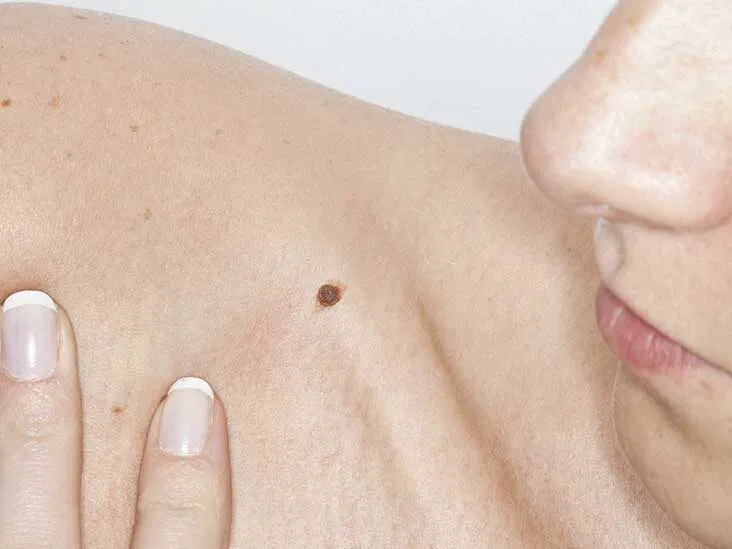

What is the meaning of crusty mole? What causes them and how can we get rid of them. We’ll tackle what can cause these crusty moles and how you can get rid of them naturally and medically.
What are they? Well, as explained by Medicalnewstoday.com, “moles also known as melanocytic nevus are small lesions in the skin. They are a collection of melanocytes and melanocytes are the melanin-producing cell that gives skin its color.” In simple terms, they are growths on the skin that are normally black or brown and can grow anywhere on the skin. They can be alone or appear in clusters.
They usually result when the cells (melanocytes) on the skin grows in a cluster rather spreading. Exposure to the sun may darken them.
Before we proceed to what causes crustiness moles on the skin, it is worth to understand what the phrase “crust’ stands for. A crust is formed the outer layer of the solid matter when body exudates or secretions dry over the skin surface.
So, why would moles be crusty? To get the correct answer, we should see what they contain. Here is what a mole could contain:
Having familiarized with their structure, let us see what can make them crusty
Factors and conditions that can make them dry can lead to crustiness. These usually involve disorders that can limit the production of sebum or condition that can rob the natural oil of the moles. They may include:
Whether bacterial, fungal or viral infection, all can contribute crustiness. These infections may result in sore moles which may develop crust while they to tend to heal.
Moles injuries can damage its skin leaving behind open sores. The exudates resulting from sores will dry leading to the development of crusts. Also, if they scratched maybe if they are itchy, they may form sore and they will tend to be crusty as they heal.
Many skin conditions can result in this problem. They can emerge due to allergens, irritants, infections, due to side effects of certain medications or as a result of systemic health conditions such as heart, kidney or lung problems. Thyroid problems can also lead to dryness of the moles and thus make them crusty.
Changes in weather is another factor that can result to dry moles. Hot and dry weather can erode the natural oil that lubricates the skin. This will make them dry and thus can easily develop crusts. Measures to prevent dryness should be taken immediately changes in the weather is discovered.
The earlier the crustiness on mole is identified on your skin and treated, the better. Symptoms regarding this condition rely on the causes, they can mild or more serious. They can come and go or remain constant. See some of the common symptom or signs include:
Other symptoms such as high fever, sores throat, vomiting, nausea and so forth signify life-threatening conditions that may not related to just the moles. Seek medical attention immediately in case of such symptoms.
The symptoms above or a combination of them can be examined to know the reasons behind crustiness. Another important point to note is that many moles are benign and nothing to worry about. However, some that are cancerous or that appear after the age of 20 need to be checked
During diagnosis, there may be a physical examination. Medical and family history of the victim may also be evaluated. To determine whether their infection or not, a biopsy may be done.
You may also be asked questions regarding what soaps or cosmetic you are using. Your diet may also be scrutinized. Once causes is known, proper treatment will be administered.
Can crusty moles be prevented or treated? What kind of treatment is effective? Can I try over the counter products, home remedies or must I go for prescribed treatments?

Also referred to as excision biopsy. It entails the entire crusty mole removal including the surrounding parts of unaffected skin is cut off.
There are many other treatments such as freezing, laser removal, among others which your doctor or may recommend after assessing your case.
Home products are also effective and appropriate for treating crusty moles. Just choose one remedy and use it consistently.
Baking soda and with castor oil can be mixed to make an effective home remedy for crusty mole. The mixture also helps in reducing the possibility of more dryness aftermath. Apply the mixture on the affected area once daily for better results.
Apple cider vinegar lowers the pH of the skin and also has antibacterial properties that make it ideal for fighting the bacteria causing crustiness. Imagine it’s just simple as that. It also has many nutrients that can nourish your skin. To apply this remedy:
First, lemon juice has antiseptic and moisturizing properties that can be very useful for many skin conditions. It also works well in getting rid of dead skin cells and leaving the rest of the skin smooth and healthy.
Procedure 1: With coconut oil
Procedure 2: With Honey
This is the king of herbs and has been in use to treat many skin conditions for years. It has cooling, soothing, moisturizing and cleansing properties that enable it to treat many skin disorders. There are many aloe Vera products available over the counter but we prefer fresh cut aloe gel. This is how aloe vera is applied:
This another wonderful remedy for healing crusty mole. It has antibacterial properties that kill the bacteria that may cause infection. It can also be added to shampoo to effectively soothe a dryness. Tea tree oil can be applied following the procedure below:
We have mentioned the fact that this is a condition that should not make us panic a lot. It can be easily healed at home but when over the counter products and home products becomes ineffective, you are supposed to see you GP immediately. Your crusty mole, in this case, maybe due to something serious. Your GP or dermatologist may prescribe other treatment options.